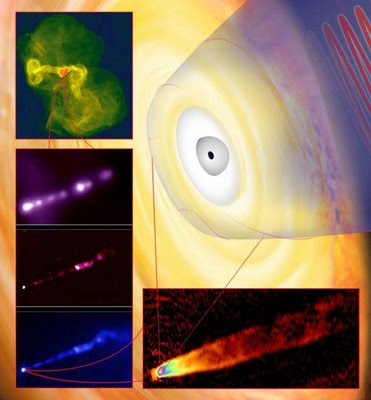 Utilizando una red mundial de telescopios, los astrónomos han descubierto estallidos de rayos cósmicos de muy alta energía de una galaxia gigante, que salen de una región muy cercana al supermasivo agujero negro de su núcleo central. El descubrimiento da nueva información sobre el misterioso funcionamiento de estas poderosos motores que existen en el centro de innumerables galaxias a los largo del Universo.
Utilizando una red mundial de telescopios, los astrónomos han descubierto estallidos de rayos cósmicos de muy alta energía de una galaxia gigante, que salen de una región muy cercana al supermasivo agujero negro de su núcleo central. El descubrimiento da nueva información sobre el misterioso funcionamiento de estas poderosos motores que existen en el centro de innumerables galaxias a los largo del Universo.La galaxia M87, a 50 millones de años-luz de la Tierra, contiene en su centro un agujero negro seis millones de veces más masivo que el Sol. Los agujeros negros son concentraciones tan densas de materia, que ni la luz puede escapar de su atracción gravitatoria. Se cree que un agujero negro atrae materia de sus alrededores, que al caer hacia hacia el agujero, forma un disco compacto rotatorio.
Los procesos cerca de este "disco de acreción" alimentados por la inmensa energía gravitatoria del agujero negro, expulsan material energético a miles de años-luz, produciendo los "chorros" que emergen de muchas galaxias. En 1998, los astrónomos descubrieron que M87 estaba también emitiendo destellos de rayos gamma un billón devecs más energéticos que la luz visible. Sin embargo, los telescopios que los descubrieroon no pudieron determianr con exactitud en qué lugar de la galaxia se originaban.
En 2007 y 2008, los astrónomos que utilizaban estos telescopios de rayos gamma combinaron esfuerzos con un equipo que utilizaba el conjunto transcontinental de telescopios VLBA (Very Long Baseline Array) de la Fundación Nacional para la Ciencia (National Science Foundation) de los E.E..U. Según indica Craig Walker, del Observatorio Radio Astronómico nacional (NRAO), "al combinar las observaciones de rayos gamma con ls visión superaguda del VLBA, pudimos ver que los rayos gamma salen de una región muy cercana al mismo agujero negro" .
M87 es la mayor galaxia del cluster Virgo, en el centro de un supercluster de galaxias que incluye el Grupo Local del cual forma parte nuestra Vía Láctea. El agujero negro de M87 tiene un "horizonte de sucesos" del cual no puede escapar la materia, de un tamaño del doble de nuestro sistema Solar, es decir una muy pequeña fracción de la galaxia. Las nuevas mediciones indican que los rayos gamma salen de un área no más grande que 50 veces el tamaño del horizonte de sucesos.
 Using a worldwide combination of diverse telescopes, astronomers have discovered that a giant galaxy's bursts of very high energy gamma rays are coming from a region very close to the supermassive black hole at its core. The discovery provides important new information about the mysterious workings of the powerful "engines" in the centers of innumerable galaxies throughout the Universe.
Using a worldwide combination of diverse telescopes, astronomers have discovered that a giant galaxy's bursts of very high energy gamma rays are coming from a region very close to the supermassive black hole at its core. The discovery provides important new information about the mysterious workings of the powerful "engines" in the centers of innumerable galaxies throughout the Universe.The galaxy M87, 50 million light-years from Earth, harbors at its center a black hole more than six billion times more massive than the Sun. Black holes are concentrations of matter so dense that not even light can escape their gravitational pull. The black hole is believed to draw material from its surroundings -- material that, as it falls toward the black hole, forms a tightly-rotating disk.
Processes near this "accretion disk", powered by the immense gravitational energy of the black hole, propel energetic material outward for thousands of light-years. This produces the "jets" seen emerging from many galaxies. In 1998, astronomers found that M87 also was emitting flares of gamma rays a trillion times more energetic than visible light. However, the telescopes that discovered these bursts of very high energy gamma rays could not determine exactly where in the galaxy they originated.
In 2007 and 2008, the astronomers using these gamma-ray telescopes combined forces with a team using the National Science Foundation's continent-wide Very Long Baseline Array (VLBA). "Combining the gamma-ray observations with the supersharp radio 'vision' of the VLBA allowed us to see that the gamma rays are coming from a region very near the black hole itself", said Craig Walker, of the National Radio Astronomy Observatory (NRAO) .
M87 is the largest galaxy in the Virgo Cluster of galaxies, at the center of a supercluster of galaxies that includes the Local Group, of which our own Milky Way is a member. The black hole in M87 has an "event horizon," from which matter cannot escape, roughly twice the size of our Solar System, or a tiny fraction of the size of the entire galaxy. The new measurements indicate that the gamma rays are coming from an area no larger than 50 times the size of the event horizon.
Tomado de/Taken from Science Daily/ Eureka Alert
No hay comentarios:
Publicar un comentario